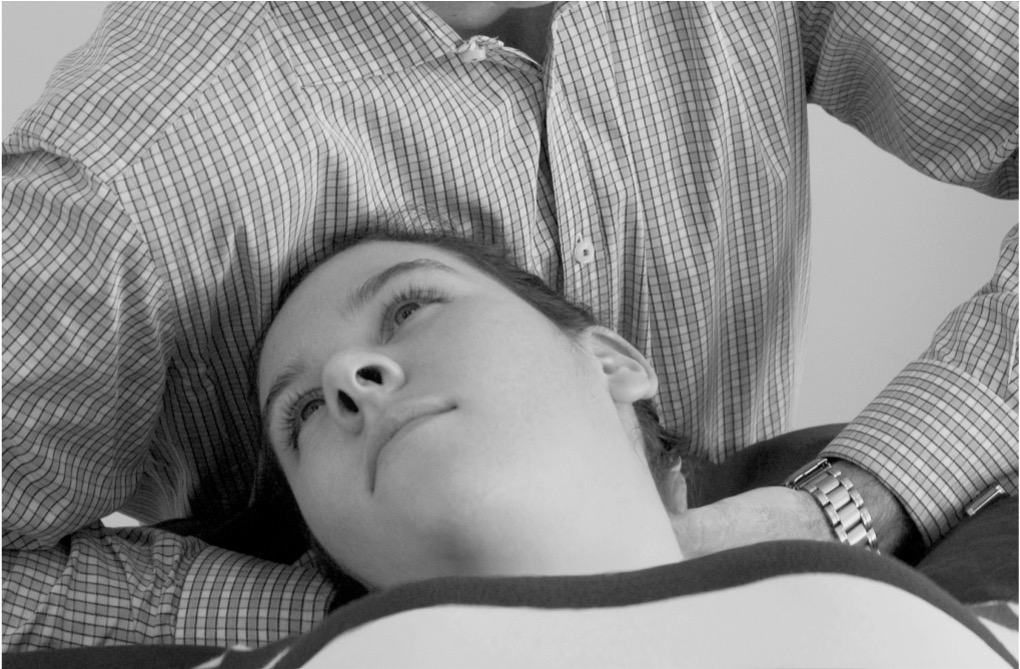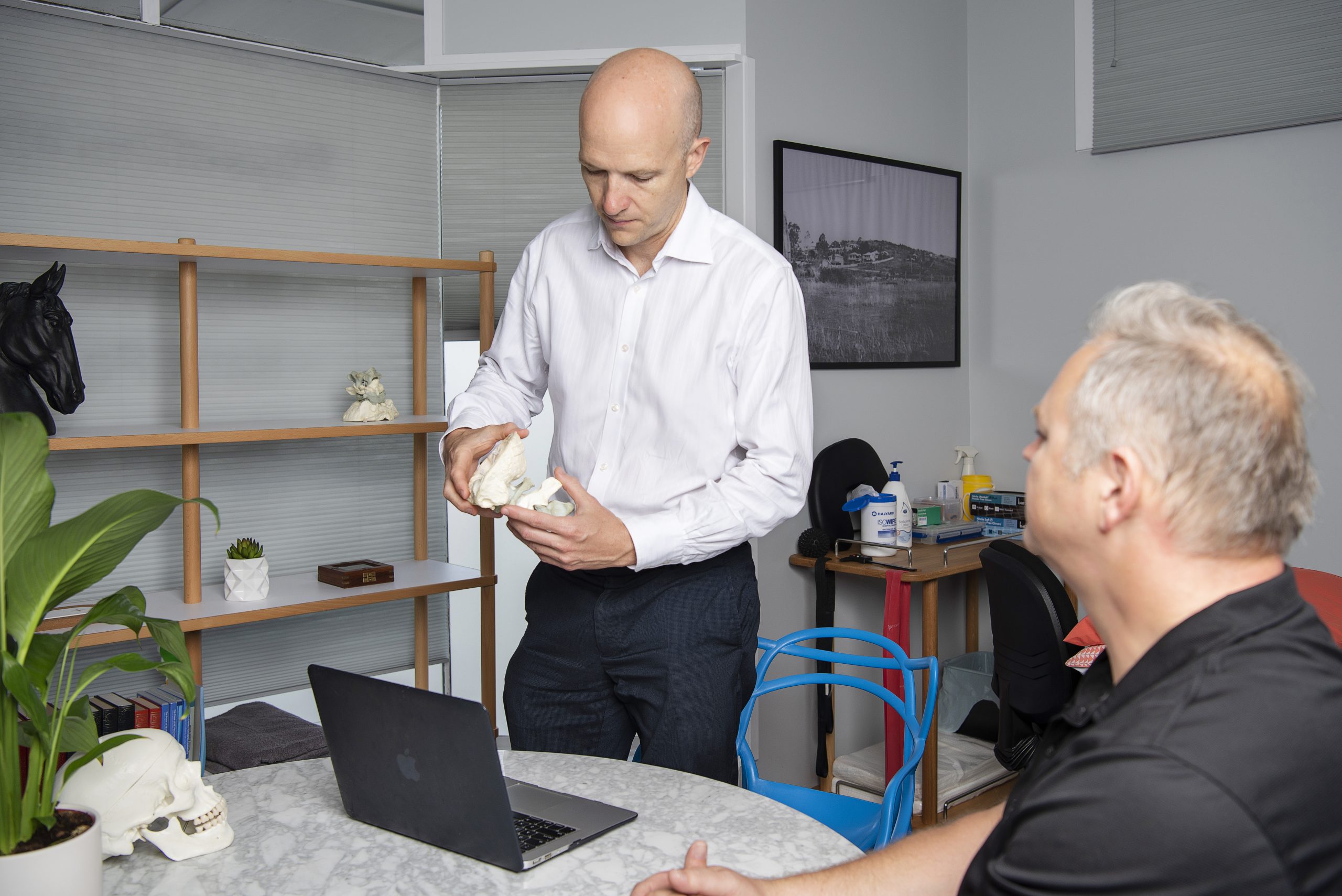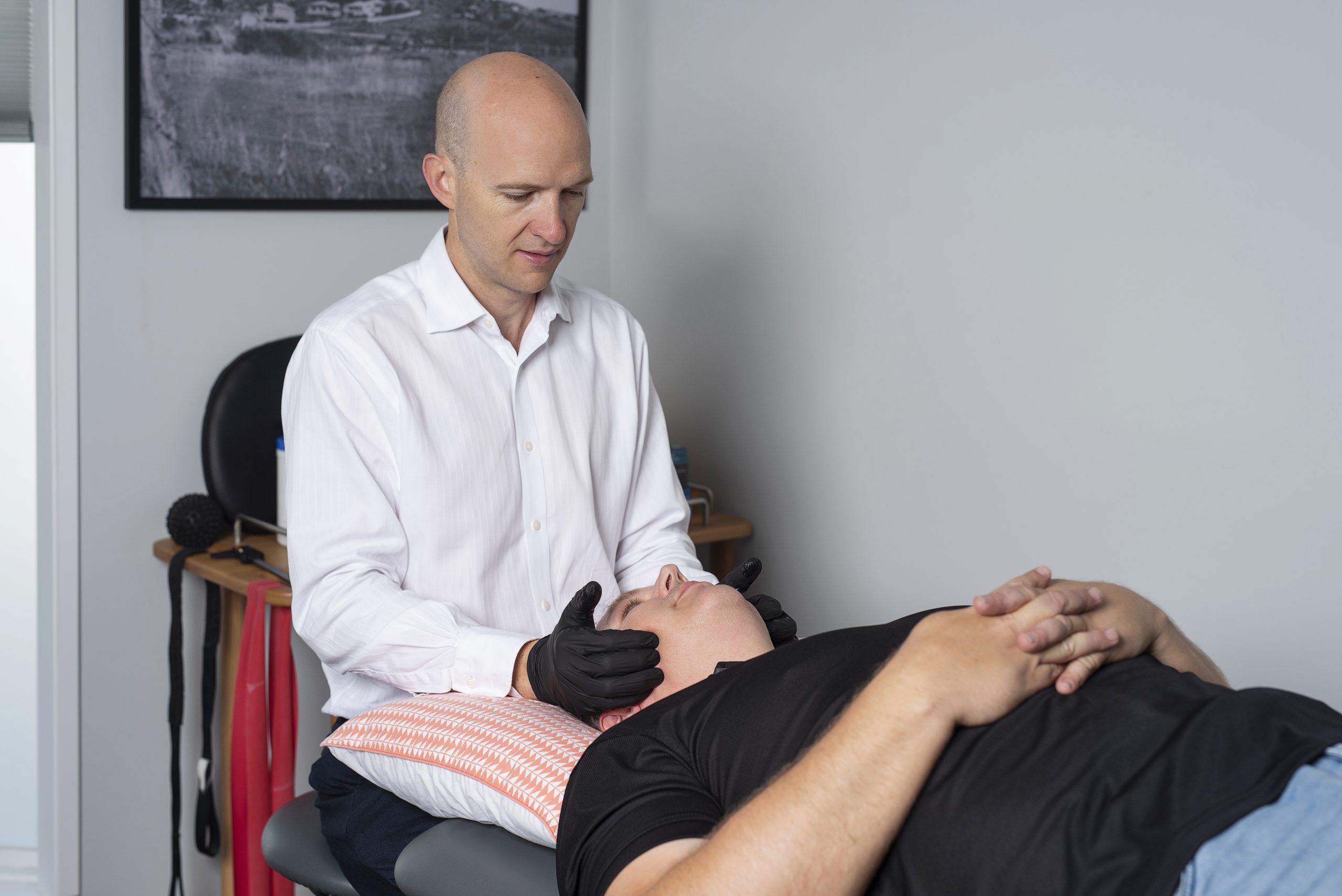Headache Treatment
At the Headache, Neck and Jaw Clinic, our clinicians provide headache treatment and pain relief for a broad range of chronic headache conditions.

Headache Treatment & Physiotherapy Specialists in Brisbane
Headaches and migraines are extremely difficult to treat for a variety of reasons. No two migraines are the same, and symptoms can vary from person to person and from one episode to the next.
You may not have thought of physiotherapy as your first treatment for headaches, but there is increasing body of research that indicates the origin of many headaches is sensitivity of the upper cervical spine, aka the neck.

You’ve probably tried postural strength training before, to no real effect. That’s because you won’t get any meaningful change until you have addressed the underlying neural cause of the pain. Real change doesn’t come from a few exercises. It comes from targeted, hands-on physiotherapy that effectively reduces headache and migraine symptoms when the neck is involved. By addressing dysfunction in the upper cervical spine—a key but often overlooked trigger—this approach provides lasting relief.

Signs and symptoms your neck is involved include (but isn’t limited to):
- Neck pain before or during your headache/migraine
- You feel your headache/migraine mostly on one side of your head
- Your headache/migraine swaps sides during its course or between episodes
- Gets worse as the day goes on
- Gets worse with poor posture or neck movements
At the Headache, Neck & Jaw Clinic, our physiotherapists are certified in the Watson Headache Approach®, a specialised technique developed by Australian physiotherapist Dr Dean Watson for the examination and treatment of headache and migraine conditions.
Undergone Physiotherapy for Headache Treatment Before That Didn’t Work?
Unless you’ve had specialised training in treating headaches and migraines, figuring out where they really come from is mostly guesswork. The reality is that most headaches and migraines are the result of neural sensitivity issues, not tight muscles, stiff joints, or dehydration.
Neural sensitivity is when a normal stimulus, like exercising, eating chocolate, or sitting at a computer, gets distorted and amplified, triggering a pain response in the nerves that serve the head and neck.
Physiotherapists with specialised training have the diagnostic skills to assess these neural pathways and identify what is driving the headache or migraine. Most physiotherapists and health professionals don’t have these specialised diagnostic skills, which leads to short lasting or ineffective treatment outcomes.
The team at the Headache, Neck & Jaw Clinic have dedicated their clinical practice to being able to identify and differentiate the involvement of all the neck joints, muscles and nerves in the upper cervical spine to determine exactly what structures are causing your headache or migraine
We have a deep understanding of how these nerves interact with the head, temple, brow, sinuses, eye, jaw, ear and face, and we can predict exactly what structures need to be assessed based on your description of symptoms.
If you saw a physio for headaches in the past and didn’t get the result you wanted, it doesn’t mean you can’t be fixed. It simply means your headache is complex and is most likely coming from neural sensitisation in your neck, rather than simply just the muscles of joints.
Understanding Headache Symptoms
Understanding your headache symptoms means first understanding where it hurts and what it feels like. This information will help plan our hands-on treatment strategy. It is just as important that we understand how these symptoms are impacting your lifestyle. Once we know what you’re missing out on, we can develop strategies to change that.

Common Headache-Related Symptoms We Hear From Clients
- Pain starting in base of neck and radiating up
- Tension/painful pressure across forehead and temple (one side or both)
- Pain deep behind eye socket
- Temple throbbing or aching
- Sharp shooting pain over the top of the head (usually one side only)
- Piercing pain like needle going through the head
- Pain in jaw, sinus, teeth, throat, ear, tinnitus
- Fatigue, lethargy, burn out
- Brain fog, inability to concentrate, and loss of time and place
- Visual disturbances, sensitivity to loud noises and bright lights
- Depression/despair
- Loneliness
- Intrusive thoughts
Book Your Treatment Today
Identifying the triggers and underlying causes of your headaches is the first step towards recovery. Book an appointment at the Headache, Neck and Jaw Clinic, and our physiotherapists can help you find relief.

The Hidden Costs of Headaches and Migraines
- Lost time at work/financial burden
- Academic penalty/difficulty concentrating or studying
- Missing family events, social gatherings or celebrations
- Side effects of medications
- Carers fatigue: caring for children or parents can make your symptoms worse
- Avoiding triggers such as alcohol, cheese, chocolate, exercise, periods
- Neglecting family members
- Reduced quality of life and self-esteem
- Adverse health outcomes from sedentary lifestyle
Different Types of Headaches
- Migraine with/without Aura (sensory disturbances)
- Tension Headache
- Menstrual Migraine
- Cervicogenic Headaches
- Cyclic Vomiting Migraine
- Trigeminal Cephalgia/Neuralgia
- Concussion-related Headaches
Cluster Headaches
Hemicrania Continua

What To Expect From Your Assessment
Comprehensive examination
As part of your examination, we’ll listen to your story and discuss the headache and migraine symptoms you experience.
Hands-On Assessment
We assess the joints in your upper neck to determine the potential source of your headache or migraine symptoms
Symptom Relief
We use slow and sustained techniques and do not do any cracking or high velocity techniques. You are always in control.
Patient Education
Our physiotherapists can provide education and answer any questions so you understand the cause of your headaches.
Pregnancy Support Pillows
Many of our headache and migraine treatments require patients to lie on their tummy—but we know that’s not always easy during pregnancy or with breast tenderness. That’s why we offer pregnancy support pillows designed to help you lie comfortably and safely, even in the later stages of pregnancy. You can relax and focus on feeling better—while we focus on delivering the best care possible.

How We Can Help With Headaches
Our headache physiotherapists take a different approach to helping you with your headache or migraines.
Initial appointments are an hour long, because that’s how long it takes to truly understand what you need from treatment and why. It starts with listening: What does your headache mean to you? How does it affect your daily life? What key life moments are you missing out on? What treatments have you already tried?
From there, we walk you through what we’re looking for, what is considered normal, the tests we’ll run, what we expect to find, and how we’ll approach treatment. For example, you might experience a single type of headache or several at once, such as daily tension headaches, monthly menstrual migraines, and a severe migraine with aura every six months that leaves you stuck in bed.
We want to understand the specifics of each based on the following four criteria:
Frequency – How often do you get headaches? Daily, weekly, monthly?
Duration – Do they last hours or days? Do they respond to medication?
Intensity – We use a simple pain scale (0–10) to track severity over time.
Location – Where do you feel it? In your neck, temples, eye, jaw, sinuses? Is it always on one side, or does it switch?
We know treatment is working when we’re able to reduce or relieve your pain during the session, even your first session. If you’re symptom-free at the time of your consultation, we can still assess your neck and work within your unique pattern to help keep headaches at bay, ideally, pushing them back further than your usual cycle.
After 3 to 4 treatments, we remeasure the four factors to check for changes, including:
Frequency of headaches
Intensity of pain
Duration of each episode
Effectiveness of medication
Presence of associated symptoms like nausea or light sensitivity
If we see progress, great! We keep going. The goal is to move you from your current regular, painful episodes to longer, pain-free periods.
If we don’t see any change after four sessions, we’re honest. This treatment likely isn’t for you. We can’t fix every headache, just the ones coming from your neck. No endless appointments. No guesswork.
Headache Conditions We Treat
Our physiotherapists treat headaches and migraines that have a cervicogenic component which include, but aren’t limited to:
- Migraine with/without Aura (visual disturbances, light sensitivities etc)
- Tension Headache
- Menstrual Migraine
- Cervicogenic Headaches
- Cluster Headaches
How Specialised Physiotherapy for Headaches Works
To understand how our physiotherapy for headaches works, we need to understand a bit about what is actually causing your headache. So this is where we will get a bit more technical about how treating your neck can change your headache.
Cervicogenic headaches are a recognised condition that cause pain or tension from the base of the skull through to the crown, temples, jaw, sinuses and behind the eyes.
A cervicogenic headache occurs when the nerves that innervate the top of the neck (joints, muscles, discs, ligaments, blood vessels) get irritated and become hypersensitive to stress, either physical or emotional.
A nerve’s role in the body is to carry a message from a specific area of the body to the brain to determine if any action is required. A motor nerve tells muscle to contract or relax, and a sensory nerve carries information about hot, cold, pressure, and most importantly, pain.
There is a supercomputer in your brainstem called your trigeminocervical nucleus (TCN), and this computer processes all the information coming from your neck, jaw, head, and face. There are millions of neural signals coming through the TCN every minute, and if your brain had to action all of them, it would shut down. Instead, the TCN identifies all non-essential information and filters it out, allowing only the important stuff to get through to your cortical consciousness.


A good example of how this works is if you're wearing a wristwatch or a necklace right now. That jewellery is constantly pressing against your skin, and your sensory nerve endings are sending signals to your brain saying they’re being compressed. But because your brain recognises this as safe, it filters out those signals at the brainstem, so you’re not even aware of the sensation. The moment you stop and focus on your watch or necklace, you can feel it again because you're consciously overriding that filter.
The real issue behind many headaches—including but not limited to cervicogenic headaches—is a sensitised TCN. When the TCN becomes overly sensitive, it stops filtering harmless signals and lets too many through, irritating the brain. This overload causes normal sensations to be perceived as pain, and the brain can’t easily switch it off.
The TCN shares a “workspace” with the trigeminal nerve, which serves the face, jaw, sinuses, and chewing muscles. When the TCN is sensitised, it can’t distinguish where the stress is coming from and spreads pain across these areas. So, poor posture stressing the neck can trigger pain that feels like a headache in the head and face.
This hypersensitivity explains why something like a wristwatch, necklace, bra strap, or bag strap suddenly feels unbearable. Not because they changed, but because your nerves can’t filter the sensation anymore.
Another nerve nearby, the glossopharyngeal nerve, sends temperature signals from the tongue and palate. That’s why eating something very cold quickly can cause a “brain freeze” headache. Cold signals trigger the trigeminal nerve via the TCN.
Central sensitivity is a key factor in cervicogenic headaches and is present to some degree in almost all headaches. Hands-on physiotherapy, especially using The Watson Headache® Approach, is the gold standard treatment to control intensity, duration, frequency, and location of symptoms in nearly every headache or migraine we treat.
The Watson Headache® Approach
The Watson Headache® Approach is about reprogramming the neural pathways to respond appropriately to a normal stimulus. A cervicogenic headache is a disproportionate response to a normal stimulus: light touch causing pain. Nothing is broken or torn or damaged, so if we can change how your brain reacts to this stimulus, we can change your symptoms. We do this via the TCN.
There are two key parts for treating headaches with this method:
Symptomatic relief to get you feeling better now (treating symptoms)
Neural reprogramming, which keeps you feeling better in the long term (treating root cause)
The C2 vertebral segment is the key structure that drives irritation of the central nervous system and the TCN. It’s the primary focus of our physiotherapy assessment and treatment for cervicogenic headaches and migraines. We can often predict your pain patterns based on how this segment is rotated, and correcting it can reduce both stiffness and nerve irritation.
If you have a headache during your initial session, we target the C2 segment to try to ease your current symptoms. If your pain decreases during treatment, it’s a strong sign your neck is involved.
If you're not experiencing a headache at the time, we can gently apply controlled stress to the neck joints or nerves to reproduce and then resolve your typical headache symptoms. This might sound unsettling, but if we can reliably trigger your familiar headache, it confirms that neural sensitivity is at play, and that you’re in the right place.
Curious to learn more? You can dive deeper into The Watson Headache® Approach here.
Reach Out To Us!
Get in touch with us today for more information on our services or to make an appointment with our friendly team.
Ready To Book Online?
Living with chronic headaches and pain? You can now book your headache treatment appointment online at any time!

Frequently Asked Questions
Headache physiotherapy targets the underlying mechanical and neural issues in the neck, particularly the C2 vertebral segment and the trigeminal cervical nucleus (TCN). Through hands-on techniques and specific testing, we reduce nerve sensitivity, improve mobility and retrain the brain’s response to harmless signals, helping to relieve headache and migraine symptoms at the source.
While medication can temporarily reduce pain, physiotherapy works to address the root cause of your symptoms. By restoring proper function to the upper cervical spine and calming nerve sensitivity, physiotherapy aims for long-term relief, fewer flare-ups, and less reliance on medication over time.
Most people notice a change within the first few sessions. After 3–4 treatments, we remeasure key indicators like frequency, intensity, duration, and medication response to track progress. If we see no improvement, we’ll be honest with you and help you find the next best step.
Yes. We can safely and gently stress the neck to reproduce your typical symptoms. If we can recreate your headache, we know the neck is involved and that you’re in the right place for treatment.
That’s a great sign! Some people experience relief early, but we still recommend following through with a treatment plan to stabilise the improvement and reduce the chance of recurrence.
Yes. The Watson Headache® Approach is a safe, evidence-based method for assessing and treating headaches and migraines, with no high-velocity manipulations. All techniques are gentle and tailored to your symptoms and tolerance.
We treat a range of headaches, including cervicogenic headache, tension-type headache, migraine (with or without aura), menstrual migraines, and mixed headache presentations. The key is identifying central sensitivity and cervical involvement.
